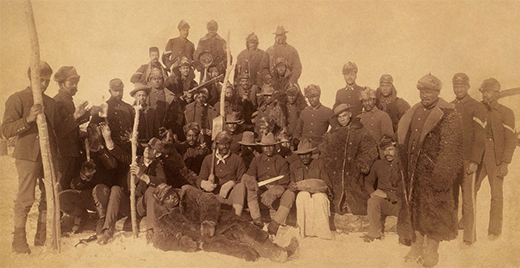| << Chapter < Page | Chapter >> Page > |
In the nineteenth century, as today, it took money to relocate and start a new life. Due to the initial cost of relocation, land, and supplies, as well as months of preparing the soil, planting, and subsequent harvesting before any produce was ready for market, the original wave of western settlers along the Oregon Trail in the 1840s and 1850s consisted of moderately prosperous, white, native-born farming families of the East. But the passage of the Homestead Act and completion of the first transcontinental railroad meant that, by 1870, the possibility of western migration was opened to Americans of more modest means. What started as a trickle became a steady flow of migration that would last until the end of the century.
Nearly 400,000 settlers had made the trek westward by the height of the movement in 1870. The vast majority were men, although families also migrated, despite incredible hardships for women with young children. More recent immigrants also migrated west, with the largest numbers coming from Northern Europe and Canada. Germans, Scandinavians, and Irish were among the most common. These ethnic groups tended to settle close together, creating strong rural communities that mirrored the way of life they had left behind. According to U.S. Census Bureau records, the number of Scandinavians living in the United States during the second half of the nineteenth century exploded, from barely 18,000 in 1850 to over 1.1 million in 1900. During that same time period, the German-born population in the United States grew from 584,000 to nearly 2.7 million and the Irish-born population grew from 961,000 to 1.6 million. As they moved westward, several thousand immigrants established homesteads in the Midwest, primarily in Minnesota and Wisconsin, where, as of 1900, over one-third of the population was foreign-born, and in North Dakota, whose immigrant population stood at 45 percent at the turn of the century. Compared to European immigrants, those from China were much less numerous, but still significant. More than 200,000 Chinese arrived in California between 1876 and 1890, albeit for entirely different reasons related to the Gold Rush.
In addition to a significant European migration westward, several thousand African Americans migrated west following the Civil War, as much to escape the racism and violence of the Old South as to find new economic opportunities. They were known as exodusters , referencing the biblical flight from Egypt, because they fled the racism of the South, with most of them headed to Kansas from Kentucky, Tennessee, Louisiana, Mississippi, and Texas. Over twenty-five thousand exodusters arrived in Kansas in 1879–1880 alone. By 1890, over 500,000 blacks lived west of the Mississippi River. Although the majority of black migrants became farmers, approximately twelve thousand worked as cowboys during the Texas cattle drives. Some also became “Buffalo Soldiers” in the wars against Indians. “Buffalo Soldiers” were African Americans allegedly so-named by various Indian tribes who equated their black, curly hair with that of the buffalo. Many had served in the Union army in the Civil War and were now organized into six, all-black cavalry and infantry units whose primary duties were to protect settlers from Indian attacks during the westward migration, as well as to assist in building the infrastructure required to support western settlement ( [link] ).

The Oxford African American Studies Center features photographs and stories about black homesteaders. From exodusters to all-black settlements, the essay describes the largely hidden role that African Americans played in western expansion.
While white easterners, immigrants, and African Americans were moving west, several hundred thousand Hispanics had already settled in the American Southwest prior to the U.S. government seizing the land during its war with Mexico (1846–1848). The Treaty of Guadalupe Hidalgo, which ended the war in 1848, granted American citizenship to those who chose to stay in the United States, as the land switched from Mexican to U.S. ownership. Under the conditions of the treaty, Mexicans retained the right to their language, religion, and culture, as well as the property they held. As for citizenship, they could choose one of three options: 1) declare their intent to live in the United States but retain Mexican citizenship; 2) become U.S. citizens with all rights under the constitution; or 3) leave for Mexico. Despite such guarantees, within one generation, these new Hispanic American citizens found their culture under attack, and legal protection of their property all but non-existent.
While a few bold settlers had moved westward before the middle of the nineteenth century, they were the exception, not the rule. The “great American desert,” as it was called, was considered a vast and empty place, unfit for civilized people. In the 1840s, however, this idea started to change, as potential settlers began to learn more from promoters and land developers of the economic opportunities that awaited them in the West, and Americans extolled the belief that it was their Manifest Destiny—their divine right—to explore and settle the western territories in the name of the United States.
Most settlers in this first wave were white Americans of means. Whether they sought riches in gold, cattle, or farming, or believed it their duty to spread Protestant ideals to native inhabitants, they headed west in wagon trains along paths such as the Oregon Trail. European immigrants, particularly those from Northern Europe, also made the trip, settling in close-knit ethnic enclaves out of comfort, necessity, and familiarity. African Americans escaping the racism of the South also went west. In all, the newly settled areas were neither a fast track to riches nor a simple expansion into an empty land, but rather a clash of cultures, races, and traditions that defined the emerging new America.

Notification Switch
Would you like to follow the 'U.s. history' conversation and receive update notifications?